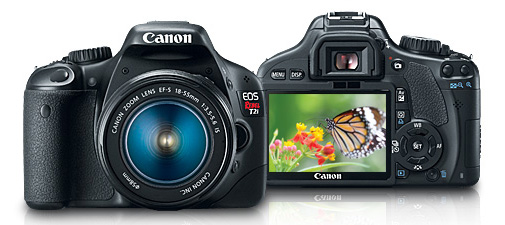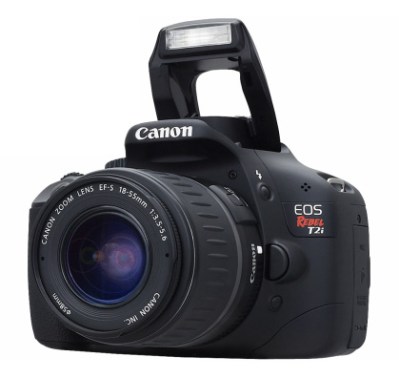“The T2i delivers accurate colors and decent noise control, but it's hard to overlook its unreliable video performance.”
- Accurate colors
- Quick response of 3.7 fps
- Good control layout
- Noise under control up to ISO 1600
- AF Assist lamp not on body
- Kit lens is weak
- Problematic videos

Introduction
There haven’t been many recent DSLR introductions for less than $999. Sure you can spend four grand for a Canon EOS 1D Mark IV or a $5,000 Nikon D3s, two of the newer ones available, but those models are really for pros. News on the affordable DSLR front has been pretty sparse—until now as Canon just introduced an upgrade for the popular T1i which remains in the line-up. The new T2i bumps up the resolution from 15 megapixels to 18MP while juicing speed to 3.7 frames per second (from 3.4). Metering is enhanced as is the LCD screen. Since this is 2010, what’s a DSLR without HD video?—and the T2i has it at improved levels (1920×1080 at 24, 25 or 30 fps versus a very jerky 20 fps for the T1i). Sounds great on paper but the real world is the only one that counts. Time to check it out…
 Features and Design
Features and Design
The Rebel EOS T2i measures 5.1×3.8×3 (WHD, in inches) and weighs around 26 ounces with lens, battery and card. It’s not nearly as beefy or speedy as the EOS 7D, but it costs a lot less. It has the form factor and heft you’d expect from a consumer-oriented DSLR which isn’t a bad thing. The grip has a nice rubberized texture as does the thumb rest on the rear. It doesn’t look like anything special–just your basic all-black DSLR.
On the front are the lens mount and release button. The camera accepts all Canon EF-S lenses and there are 60-plus to choose from. The kit lens is 18-55mm which equates to 29-88mm in 35mm terms because of the 1.6x digital factor of the APS-C sized sensor. Also here is red-eye/self-timer lamp, remote sensor, depth-of-field preview button and mic. The built-in flash acts as an AF Assist beam; you need to open it with pop-up button on the side of the camera. We’d much rather have a dedicated beam on the body itself like the Nikon D5000, one of our favorite DSLRs, which costs $799 with the 18-55mm kit lens. The Nikon is “only” a 12MP camera that shoots 720p video but the stills are top notch.
You’ll find the hot shoe, on/off switch, ISO, shutter and jog wheel and shutter button on the top of the T2i. There are 14 options on the mode dial ranging from full auto, full manual, movie, popular scene settings and so on. It’s pretty standard stuff.
The rear is dominated by a 3-inch 3:2 format LCD screen rated 1.04 million dots versus 921K for the T1i. The screen is quite good but the difference isn’t amazing from the older model. The viewfinder is decent with 95% coverage but a brighter view would be on our wish list. The control layout here is fairly typical with a four-way controller with center set button. The four points give access to focus type, Picture Style, burst/self-timer and white balance. We’d like the flash to be one of options rather than Picture Styles but that’s just us. As noted, ISO adjustment–which ranges from 100-6400 (with 12,800 custom)–is on top. This control placement wasn’t a problem at all during use. Other keys on the back include exposure compensation, playback, delete, menu and display. The Q key gives quick access to the main parameters so you can make adjustments with the jog wheel. There’s also the red dot button for Live View when in still mode or it starts recording when you’re in the mood to capture HD videos. A tiny speaker lets you hear what you’ve recorded but in the poorest fidelity you can imagine.

What’s In the Box
The camera, battery, plug-in charger, strap, USB and stereo A/V cables and a 260-page owner’s manual. You’ll also get the lens if purchase a kit. Two CD-ROMs have the imaging software and software manual. The programs feature updates of the stuff Canon’s supplied for years: Digital Photo Professional ver. 3.8, ZoomBrowser EX ver. 6.5, EOS Utility 2.8, PhotoStitch ver. 3.1, Picture Style Editor 1.7 and WFT Utility 3.5. With the battery charged and 4-gig Class 6 card in place, it was time to fire away.
 Performance and Use
Performance and Use
Canon shooters will feel right at home using the T2i since the control layout and menu system is very similar to the company’s previously-introduced DSLRs. Newbies will have no problems with it as well but they should read the manual to understand its hidden mysteries. There really aren’t any “mysteries” but most folks shoot in Auto with the default parameters. Nothing wrong with that but going beyond photographic baby steps why you buy a DSLR in the first place. The camera feels right and the bulk and weight really weren’t an issue. We had the T2i for several weeks, shooting stills and videos. For the most part, we took full-resolution JPEGs in Auto, then moved to options on the mode dial (especially macro for all the blooming flowers). Movies were captured in Full HD, 1920×1080 at 30 fps. We used the 18-55mm kit lens and a Canon 18-135mm EF-S zoom. Multiply the figures by 1.6x and you get the true focal lengths.
The T2i is a very responsive camera and quickly grabbed focus (it uses a 9-point AF system). Shooting at close to 4 frames per second really separates this type of camera from the vast majority of digicams other than the new class using Sony’s CMOS chip which captures 10 fps. After using the T2i we closely examined photos on a monitor (100% plus), made 8×10 prints with default settings and viewed the videos on a 50-inch plasma HDTV.

We weren’t disappointed with color quality of the T2i. They were very accurate in the default mode and have the pop we like so much from Canon cameras. Images of a blooming weeping cherry were just spectacular. Exposures were also on target. Sharpness is another issue to be aware of. As noted earlier, the AF Assist lamp is in the flash assembly so remember to keep it open at all times. Defeat the flash if you want to shoot in available light. With the high-resolution chip you see every flaw when you enlarge the files. That’s why we recommend opting for the body only and purchasing a quality lens if the T2i is on your shopping list. It’ll be a very worthwhile investment.
The T2i does a good job holding noise under control. As you’d expect, there were speckles galore at 12,800 but it wasn’t a disaster. We hardly saw any noise up to 800 and even 1600 was solid—you wouldn’t notice much on your prints. From 3200 and up, things proceeded quickly down hill but this is not surprising for an APS-C size sensor.
Conclusion
Reflecting on the Canon EOS Rebel T2i we feel a bit like Randy Jackson, a judge on American Idol: “Dog, we’re not digging it.” Yes, the DSLR delivers very accurate colors and noise remains under control up to ISO 1600. As a camera—with a caveat of using good glass—you’ll be satisfied with this new DSLR, especially if you keep the flash open. Yet the issue of video quality is hard to overcome. If it were our money—and movies were a non-issue—the Nikon D5000 is the pick.
Highs:
- Accurate colors
- Quick response of 3.7 fps
- Good control layout
- Noise under control up to ISO 1600
Lows:
- AF Assist lamp not on body
- Kit lens is weak
- Problematic videos

 Features and Design
Features and Design Performance and Use
Performance and Use

